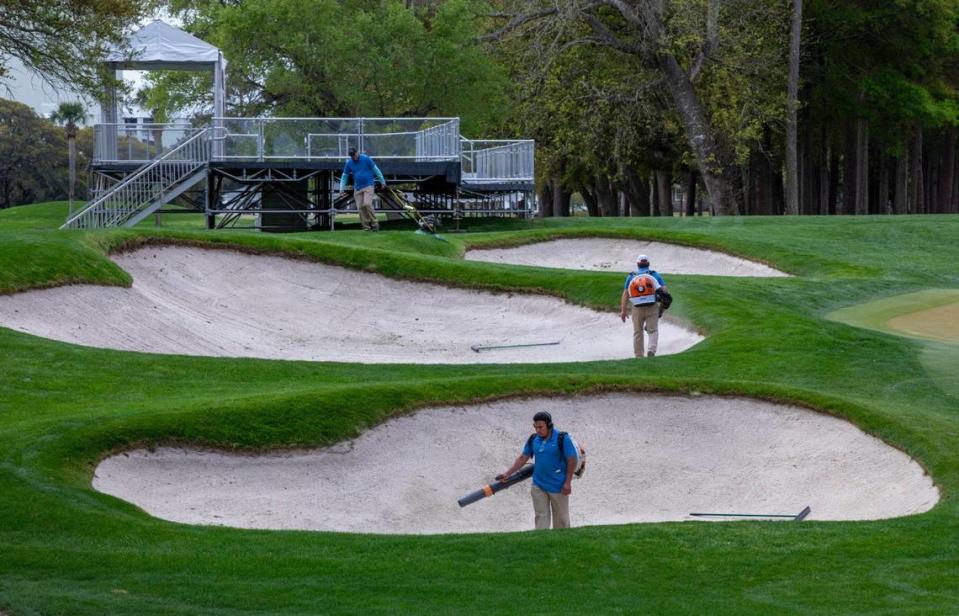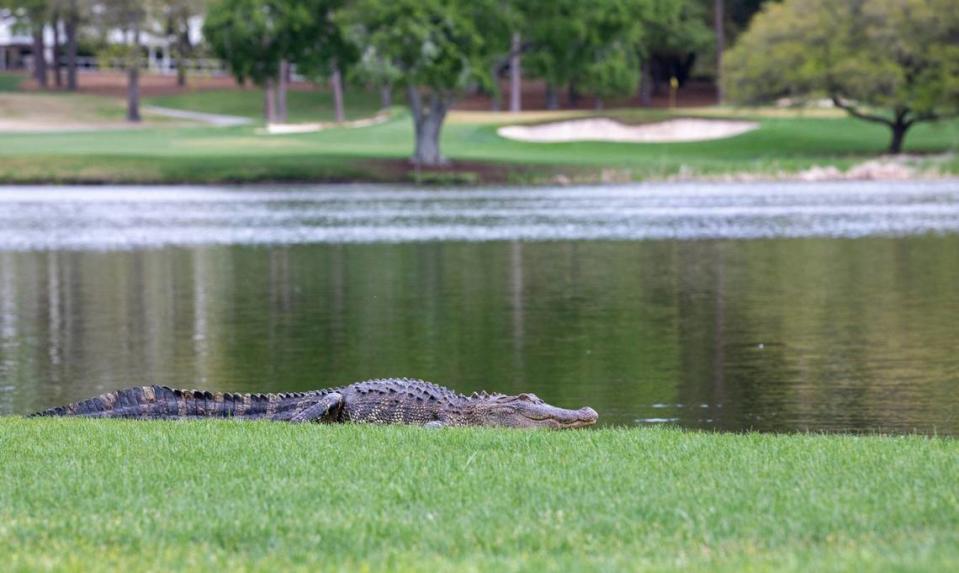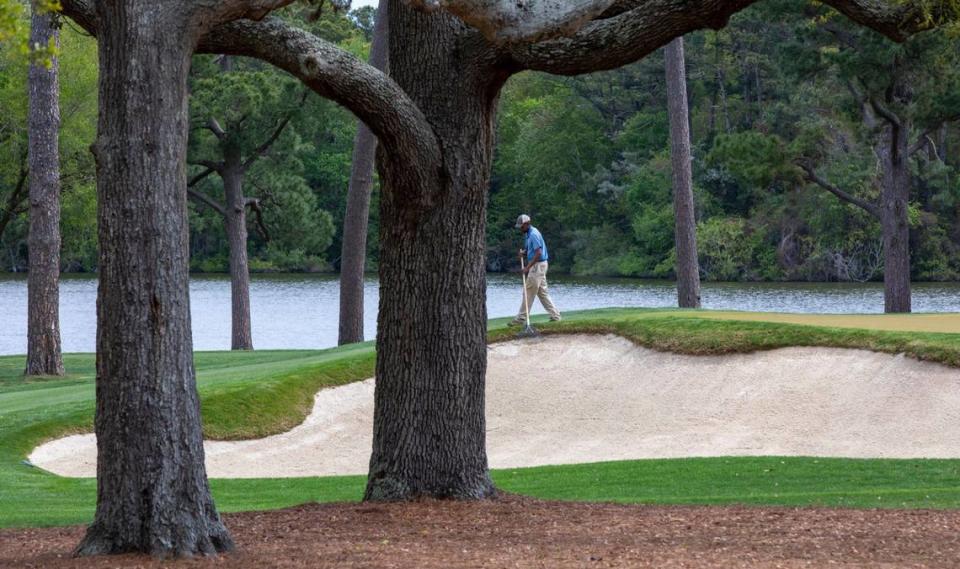Golfers at Myrtle Beach’s first PGA event to see alligators, tailgating. Here’s what else
The greater Myrtle Beach area has a well-earned reputation for providing quality golf courses for locals and visitors, and soon, PGA Tour Professionals will tee off on the Grand Strand for the first time.
The Myrtle Beach Classic, the Grand Strand’s first PGA Tour tournament, begins at the Dunes Golf & Beach Club on May 9, 2024. Many members and visitors have played the Robert Trenton Jones course since its opening in 1947.
However, May will bring a projected 10,000 people to the course, and many might wonder what to expect when watching the tournament. There are spots on the course where golfers will have trouble, interact with interesting animal, and holes that will crown the inaugural Myrtle Beach Classic champion.
Sitting in the Dunes Golf & Beach Club’s members’ locker room, which features a wall-to-wall ocean view, Head Golf Professional Dennis Nicholl, who first played the course in 1996 before becoming head professional in April 2007, said the course and event will provide players with plenty of obstacles that spectators will get to observe.
Some are minor, others are more obvious, but regardless, the golfers will have to deal with them or face the consequences of a missed shot in front of thousands of people in attendance.
While the crowds probably won’t resemble the raucous masses of the golf film character Happy Gilmore, the Dunes Golf & Beach Club’s open, scenic setting, with trees pruned to provide even greater viewing opportunities, will still give golfers plenty of challenges.
Seating sections around the 17th hole are designed so that spectators can enjoy all angles of play while partaking in tailgating and other activities, Nicholl said. The course’s critters will also have a close-up view.

Why alligators might be watching Myrtle Beach Classic with you
Indeed, the fauna will be a feature of the Dunes Golf & Beach Club’s staple hole, which would be the most intimidating to play. Known as Waterloo because it will break your golf game, just as Napoleon’s armies were broken in Belgium in 1815, the par five Hole 13 at the Dunes Golf & Beach Club has traditionally presented golfers with their greatest challenge at the course.
Even PGA Tour legend Lee Trevino disliked the hole, expressing a desire to replace the hole.
Psychologically, golfers must first deal with Lake Singleton and the length of the hole. The more than 600-yard hole wraps around Lake Singleton, populated by a lonely island within view of the hole, and constantly warns of the consequences if a player hits too far to the right.
“The trick is to get as close as you can to the water without going in,” Nicholl added.
The numerous alligators residing in Lake Singleton alongside Hole 13 won’t help the golfers either. Usually lurking in the water next to the hole, their snouts occasionally poke above the surface, letting you know they’re there; the reptiles sometimes sit still on the grass next to the water, sunbathing as golfers play. In the blink of an eye, the alligators can go from motionless to jumping back into the water, and it is possible players will have to make crucial shots as one of the reptiles watches close by.

Famed Sports Illustrated reporter Dan Jenkins complained about the gators when he named Waterloo one of the best 18 holes in America in 1965, noting a golfer could “perish by alligator bite.” While death by an alligator is unlikely, crucial shots are more probable to occur.
Nicholl said the Myrtle Beach Classic will probably be decided by how golfers play holes 10 through 14. Due to its length, Waterloo is usually the most challenging hole typical players face. Waterloo especially causes frustration when it comes to hitting over Lake Singleton on their second shot.
Nicholl, who deposited his first shot into Lake Singleton when demonstrating how PGA Tour players would play 13, said it would challenge PGA Tour golfers less than many might expect.
While alligators and water might provide a mental challenge, ball and club technology increases the distances golfers can hit, which means clearing Lake Singleton won’t be as Herculean a feat as many amateur players and spectators believe.
“For the tour player, The 13th hole is not going to be that difficult,” Nicholl said. “They’re going to tear it apart; they’re going to make birdies all day long, I would think.”
Why one hole might feel like a ‘slow, painful death’ for golfers
The other holes also present challenges. For Nicholl, tour players will find opportunities on the course’s par-five holes to boost their scorecards.
“The par fives here at this golf course, the tour players are licking their chops,” Nicholl said.
What will matter most is that players get off to a good start when they tee off at the Dunes Club. While difficult, Nicholl said the first four holes serve as players’ best opportunity to build up a good score, as the course provides few places to catch up as the front nine turns over to the back nine.
“Some courses are like the warm-up holes you get out there, and they’re a little bit easier to get you in your game. That’s not the case (here),” Nicholl said. “No. 1, you got to be ready to go right away because it’s a challenge. So some of the players that might race out and get a couple early birdies, that’s an advantage.”
Those challenges include how players will change their game to adapt to the course. Many of the front and back nine holes also feature doglegs because the layout bends into a leg-like shape as the course progresses, which will present further tactical decisions for golfers to make due to the change in direction. Holes like six, a par four, bend leftwards, and the ideal landing spot off the tee box is to the right of a fairway bunker. Surviving that obstacle, the pros will face a tricky approach shot.
There’s a sand trap in front of the green waiting to punish players who take a conservative approach, and the hole itself has a slope through the middle of the green, which Nicholl warned could cause a three-putt. Indeed, greens serve as one of the primary obstacles of the course, which is why golfers during the Myrtle Beach Classic will have to focus heavily on precision throughout their round of play.

Some holes have sloped greens, particularly 10. A par four with a fairway pond that golfers must land short of, Nicholl said, hole 10 features a false front green, meaning the incline is so great that it could cause some professionals’ golf balls to roll if they land on it. Nicholl added their best approach would be to try and aim for the middle of the green, as trying to hit over it and chip on doesn’t remove the danger caused by the false front, which could lead to the ball falling into the fairway pond if they’re unlucky enough.
“The 10th green has just been a nightmare for some players because you hit a shot that lands on the green, you kind of take a deep breath that you hit a good shot, and then all of a sudden, your ball starts to move,” Nicholl added. “It’s a slow, painful death watching it roll 30 yards down.”
The elements also contribute to the difficulties caused by the course, creating new obstacles for golfers.
The open views of the course offer little protection from noticeable gusts of wind from the beach that could impact a player’s score. Nicholl added that winds could range from 10 to 20 mph when the Myrtle Beach Classic tees off, further complicating players’ approach to the course.

